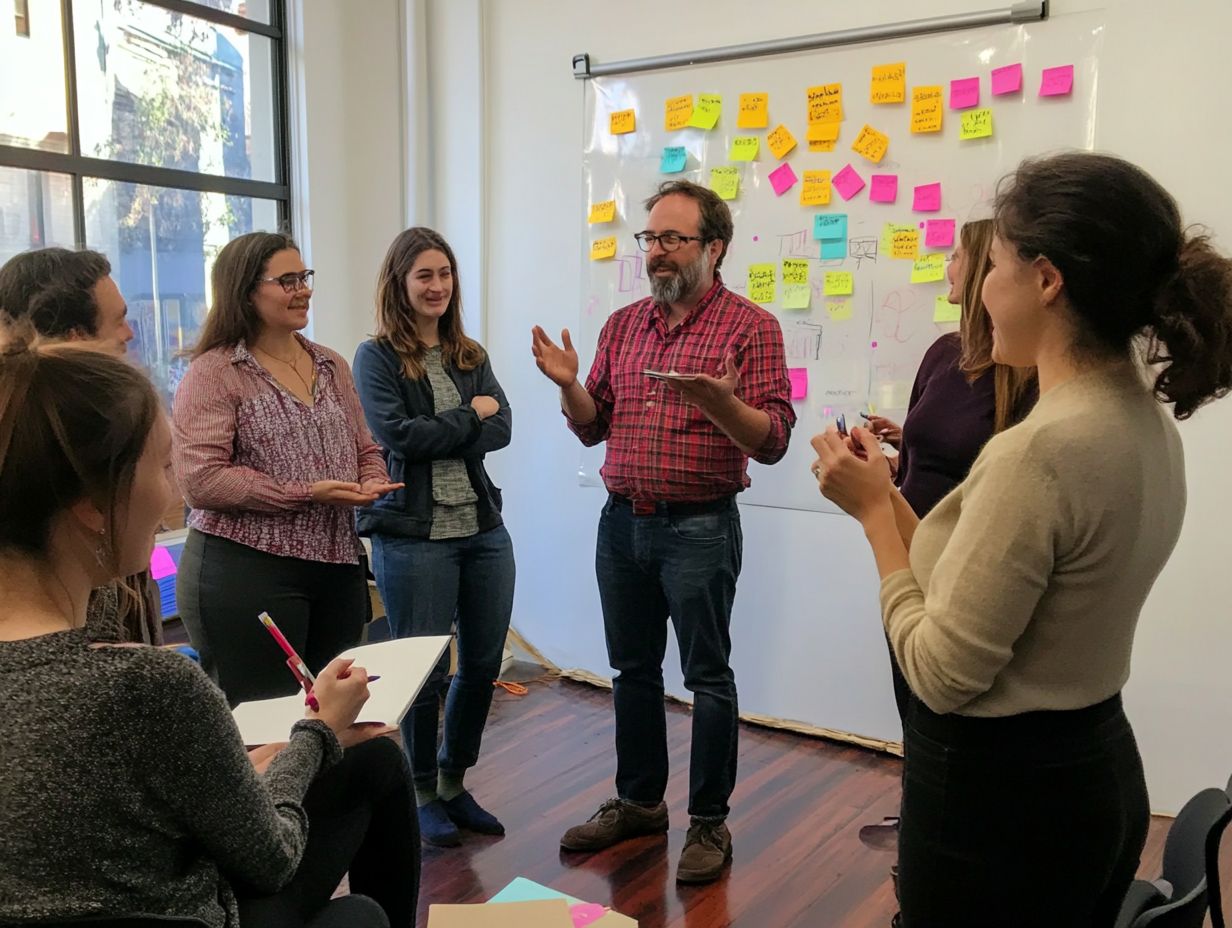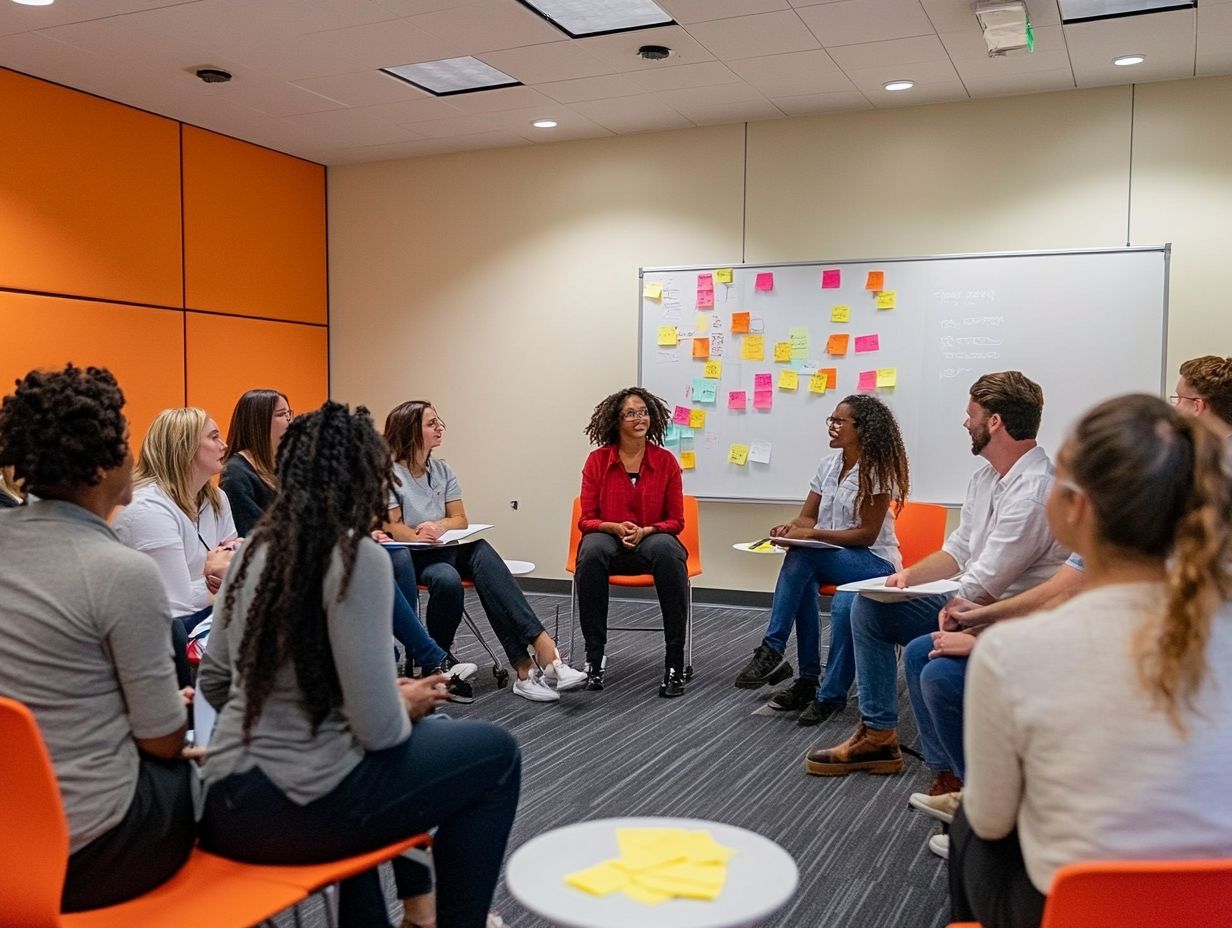How to Implement Feedback Loops in Training?
Feedback loops are essential for enriching your learning experiences, acting as a potent catalyst for improvement.
This article delves into the importance of feedback loops in training. You ll uncover strategies for implementing effective feedback and discover the crucial metrics to gauge their impact.
We will also discuss common challenges and practical solutions for integrating feedback loops into your training programs.
Continue reading to unlock the full potential of your learning journey through feedback!
Contents
- Key Takeaways:
- The Importance of Feedback Loops in Training
- The Components of Feedback Loops
- Types of Feedback Loops
- Implementing Feedback Loops in Training
- Measuring the Effectiveness of Feedback Loops
- Challenges and Solutions for Implementing Feedback Loops
- Frequently Asked Questions
- What are feedback loops and why are they important in training?
- How can I incorporate feedback loops into my training program?
- What types of feedback should I ask for in a feedback loop?
- How often should I implement feedback loops in my training program?
- What should I do with the feedback collected from trainees?
- How can I ensure that trainees feel comfortable providing honest feedback?
Key Takeaways:

- Provide timely and specific feedback to enhance learning and improve performance.
- Feedback loops consist of input, processing, and output, and can be either positive or negative.
- Effective feedback strategies and evaluation methods are essential for successfully implementing feedback loops in training.
The Importance of Feedback Loops in Training
Feedback loops are essential in training programs as they prioritize participant engagement and continuously refine training objectives.
These loops foster an ongoing dialogue between trainers and trainees. This enables real-time adjustments based on individual learner needs and performance indicators.
By integrating different kinds of feedback, you can easily track how behaviors change and improve! This ultimately elevates the effectiveness of your training.
In today s digital landscape, tools that help organize training and performance tracking software can automate feedback processes. They ensure valuable insights are collected for continual enhancement.
Why Feedback Loops are Essential for Learning
Feedback loops are integral to your learning journey. They offer a structured way to understand and enhance your behavior and performance.
These mechanisms foster a dynamic environment where you can engage in reflective practices. This drives significant behavior changes and deepens your knowledge.
Both different kinds of feedback are crucial in this process. For example, test scores or analytics provide you with clear metrics to gauge your progress.
Meanwhile, personalized comments from instructors deliver valuable insights into specific areas for your improvement. By weaving these forms of feedback into various training methods like workshops, e-learning modules, or peer reviews you can create a more effective learning atmosphere that promotes continuous growth and adaptability.
The Components of Feedback Loops
The components of feedback loops are built around three main phases: input, processing, and output. Each is essential for enhancing the effectiveness of training programs.
In the input phase, you establish data collection mechanisms like contextual surveys and participant feedback. This helps gather valuable insights from your training participants.
Moving to processing, you analyze this feedback to interpret the collected data. This helps you identify trends and pinpoint areas for improvement.
Finally, in the output phase, you implement feedback mechanisms, such as automated emails. These communicate your findings and adjustments to training methodologies based on the insights you’ve gathered.
Input, Processing, and Output
The input phase of feedback loops is all about gathering relevant data. You do this through effective feedback channels, setting the stage for processing and output.
During this stage, various techniques such as surveys, interviews, and observation can provide a comprehensive understanding of participants’ experiences.
Utilizing tools like Google Forms or SurveyMonkey can streamline your data collection. This makes it easier for participants to share their insights.
Once you ve gathered this data, feedback analysis becomes crucial. Identifying patterns and trends will help you refine processes and enhance overall engagement.
A robust feedback system might include regular check-ins and follow-up surveys to gauge satisfaction levels. This ultimately leads to actionable adjustments communicated back to participants, fostering a sense of collaboration and continuous improvement.
Types of Feedback Loops

Grasping the nuances of feedback loops particularly positive and negative ones is essential for crafting effective training methods and facilitating meaningful behavioral change among participants.
This understanding gives you the power to tailor your approach, optimizing the learning experience and ensuring that your strategies resonate deeply with those involved.
Positive and Negative Feedback Loops
Positive feedback loops can significantly enhance your satisfaction as a learner by reinforcing the behaviors you want to develop. Negative feedback loops show areas where improvement is needed.
In training contexts, these feedback loops play a pivotal role in shaping your learning environment. For example, when an instructor commends your effective communication during a group discussion, it elevates your confidence and encourages your peers to emulate that behavior, creating a positive spiral of engagement.
When you receive constructive criticism like being told your presentation was unclear it motivates you to refine your skills further. Such negative feedback loops encourage reflection on your performance and help tackle any shortcomings, ultimately enhancing your competency.
By applying both types of feedback strategically, you create an environment of continuous improvement, enabling you to thrive and adapt in ever-evolving learning landscapes.
Implementing Feedback Loops in Training
Implementing feedback loops in training demands a strategic approach that emphasizes effective feedback and addresses how to incorporate feedback into training programs, while enhancing user engagement throughout the learning journey.
This method makes learning exciting and engaging while ensuring that participants remain actively involved and invested in their development.
Strategies for Effective Feedback
Effective feedback strategies require you to employ various mechanisms that capture user opinions and align them with your training objectives.
Integrating surveys, focus groups, and one-on-one interviews will help you gather insights reflecting the performance indicators set for different training modules. For example, distributing brief surveys after a training session can show what participants found most beneficial and what might have been unclear.
Aligning this feedback with specific learning outcomes clarifies the training’s effectiveness and ensures it addresses learners’ needs. Ultimately, leveraging comprehensive feedback fosters continuous improvement, enhancing overall training effectiveness and participant satisfaction.
Measuring the Effectiveness of Feedback Loops
Measuring the effectiveness of feedback loops is vital to ensure that your training programs achieve the desired outcomes. This can be assessed through key metrics and various evaluation methods that provide a clear picture of success and areas for improvement.
Key Metrics and Evaluation Methods

Key metrics and evaluation methods, such as performance tracking and feedback analysis, are essential for assessing the effectiveness of training programs.
These tools shine a light on areas needing improvement and provide valuable insight into how well participants grasp the material and apply it in real-world situations. By leveraging customer satisfaction scores, you can measure learners’ immediate reactions to the training experience, while retention rates offer a long-term view of knowledge sustainability.
Integrating both qualitative and quantitative approaches allows you to gain a richer understanding of outcomes. Surveys and interviews reveal nuanced sentiments from learners, while data analytics quantify achievement levels, collectively providing a comprehensive picture of training efficacy.
Challenges and Solutions for Implementing Feedback Loops
Implementing feedback loops can indeed pose several challenges. Recognizing effective solutions is essential for fostering a productive feedback process that encourages continuous improvement.
By addressing these obstacles head-on, you can create an environment where growth and development thrive.
Addressing Common Obstacles
Addressing common obstacles in the feedback process calls for active steps to implement effective solutions that elevate user engagement.
This means recognizing specific challenges, such as communication barriers, ambiguity in feedback requests, and inadequate follow-up on user input.
One effective strategy is to develop structured feedback forms that guide you in providing precise insights. This ultimately leads to more meaningful contributions.
Encourage open dialogue to ignite participation. Training modifications should highlight the importance of user feedback and illustrate tangible outcomes based on your contributions. This makes you feel valued and more inclined to participate actively in future feedback loops.
Frequently Asked Questions
What are feedback loops and why are they important in training?
Feedback loops are ways to gather input from trainees to enhance training programs. They are important because they allow for continuous improvement and ensure that training is meeting the needs of the trainees.
How can I incorporate feedback loops into my training program?

Start by asking for feedback from trainees at various points throughout the training, such as after a module or at the end of the training. Use this feedback to make adjustments and improvements to the training program.
What types of feedback should I ask for in a feedback loop?
You can ask for both quantitative and qualitative feedback. This can include ratings or scores, as well as written comments or suggestions for improvement.
How often should I implement feedback loops in my training program?
You should implement feedback loops frequently to ensure ongoing improvement. Ideally, do this at multiple points during the training program. Learning how to use feedback for training improvement allows for continuous progress and ensures that trainees’ needs are being met.
What should I do with the feedback collected from trainees?
Take the feedback seriously and use it to make necessary adjustments and improvements to the training program. Communicate with trainees about the changes that will be made based on their feedback.
How can I ensure that trainees feel comfortable providing honest feedback?
Create a safe and non-judgmental environment for trainees to provide feedback. Assure them that their feedback is valued and will be used to improve the training program for future trainees.
Start implementing feedback loops today to enhance your training program and foster continuous improvement!





